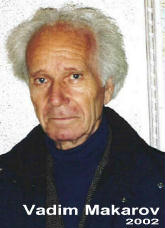"Atlas of the Snowmen"
by Vadim Yu. Makarov
The Moscow publishing house "Company Sputnik+" 2002, 311 pp.,
ISBN 5-93406-237-9 (in Russian)
 This
book is written by the active field researcher who from year to year took
part in expeditions and is familiar with the problem from within. The
main task of the author who for some last years is the Chairman of the
Russian Society of cryptozoologists - to inform the interested public
on the new information concerning to relict hominoids, which has appeared
after 1960-th years, when the main works by B.F.Porshnev were issued.
This
book is written by the active field researcher who from year to year took
part in expeditions and is familiar with the problem from within. The
main task of the author who for some last years is the Chairman of the
Russian Society of cryptozoologists - to inform the interested public
on the new information concerning to relict hominoids, which has appeared
after 1960-th years, when the main works by B.F.Porshnev were issued.
Despite of obvious difficulties in selection of an authentic material
from various sources, Makarov achived this task, having resulted in the
book with information collected from the numerous domestic and foreign
publications, letters of the encounters with hominoids, proceedings of
information materials prepared in the Society, results of numerous expeditions.
The main part of the information was not known till now outside a narrow
circle of the researchers and is published for the first time. The interesting
episodes from another countries are given also. The book is formed by
a geographical principle, so the word "Atlas" used in the title.
Here V.Yu.Makarov departs from B.Porshnev conception ("all relic
hominoids are variants of one speaces - Neanderthal and the distinctions
between them are caused by a variety of living conditions") and entroduces
inhabitance areas ("the reigns") for various types of the creatures,
using for them the local names.
The book includes
8 chapters and the most informative are "Contemporary areal of relic
hominoids (records of eyewitnesses)" and "Expeditions".
The reviews of areals begin with the European parts of the former USSR.
There are evidences from populated places such as the vicinity of Moscow
and Ukraine. Obviously, in such places hominoids do not linger over and
can not be objects of prolonged investigations. The others are more interesting
for the researchers as places permanently used by homonoids. V.Makarov
tells in detail about Caucasus, where the most numerous evidences were
received (the main collections by J.-M.Kofmann). Only the small part of
the received there data could be included in the book. The places of steady
presence of hominoids also are in north of Europe, where the natural conditions
strongly complicate observations. In the Asian part of the country many
meetings occured in the mountains of Tadjikistan.
These sections of the book are closely connected to the description of
expeditions and present their results. Many cryptozoological expeditions
were oranized and led in Tadjikistan by the author. The next interesting
area is in the north of Western Siberia (the data materials gathered by
V.M.Pushkarev). Maps and diagrams in the book specify places of meetings
with hominoids practically at all territory of the country.
The situations in
other countries and continents are described superficially to some extent.
There are few items for every geographical zone of the Earth. Some literature
sources that describe
"wild" men in the Western Europe in the Middle Ages are also
cited.
The section of expeditions is the most interesting. After a brief descriptions of well-known first travels to Himalayas V.Makarov came to expeditions of the Russian researchers. The materials about the Central Asian expeditions of the Society contain the maps, figures and descriptions with details usually accepted in scientific reports. V.Makarov for the first time gathered and presented systematically chronology of field researches by Russian cryptozoologists in the impressive table. This section gives appropriate view on large volume of the investigations which have been carried out by the enthusiasts in 80-90-th years without state's or sponsor's support. In other sections of the book the author gave the information on morphology, comparative ethology and ecology of hominoids. He said also how hominoids presented in historical literature and folklore (following to D.Bayanov). The recommendations for field work and technique of step fixing are interesting for the beginners.
Some statements of the author are rather disputable. For example, it is difficult to agree that in Fig. 84 a child of hominoid is represented, as well as with a hypothesis about a route of migration of a creature in Fig. 19.
Unfortunately, the low technical quality of the edition contrasts with its content. Photos were printed very defectively. There are a lot of typing errors in the book.
But in spite of these lacks the book will be interesting to anyone, who wish to know about researches of relic hominoids, first of all in Russia.
Michael Trachtengerts,
Ph.D., Moscow
Back to Reviews?
Back to What's New?
Back to Newspaper & Magazine Articles?
Home/Main
Portions of this website are
reprinted under the Fair Use Doctrine of International Copyright Law as
educational material without benefit of financial gain.
http://www4.law.cornell.edu/uscode/17/107.html
This proviso is applicable throughout the entire website.